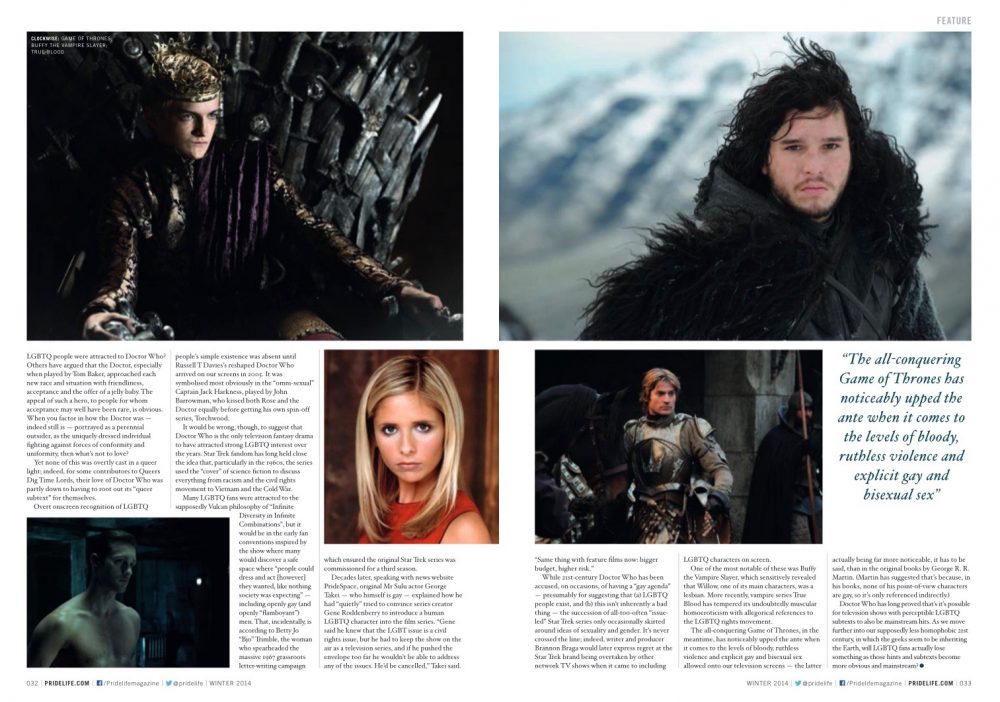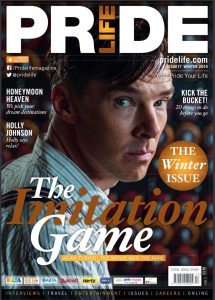
For many years LGBT people have found a ‘safe place’ in television science fiction and fantasy fandom. Paul F Cockburn asks why.
 Back in the late 1980s, I joined a group of Doctor Who fans in Glasgow, a rather anarchic get-together of young men who shared their love of the show not just with fanzines but by getting together at least once a week down the pub, which—in anticipation of a good night’s drinking—was why the group referred to itself as “Braindead”!
Back in the late 1980s, I joined a group of Doctor Who fans in Glasgow, a rather anarchic get-together of young men who shared their love of the show not just with fanzines but by getting together at least once a week down the pub, which—in anticipation of a good night’s drinking—was why the group referred to itself as “Braindead”!
But here’s the thing; of the eight-to-10 core ‘members’ of the group, at least half—myself included—eventually came out as gay, a proportion that would probably have startled Dr Kinsey. Nor did this appear to be an aberration; having been a minor “spear-carrier” in wider organised Doctor Who fandom, I’d quickly realised that a significant number of fans were not just followers of a Time Lord from Gallifrey, but Friends of Dorothy too.
As confirmed by the Hugo Award-nominated Queers Dig Time Lords—a collection of essays by British and American LGBTQ Doctor Who fans, published by Mad Norwegian Press in 2013—the Doctor and his adventures had long been precious to thousands of viewers who realised that they didn’t match societal norms around sexual attraction and gender identity.
Phil Collinson—who would work alongside Russell T Davies and Julie Gardner as Doctor Who’s Producer and Executive Producer between 2004 and 2008—certainly felt the connection. In a March 2007 interview, he said: “For me, as a young boy and a teenager, growing up in the north of England, in a world where I could never imagine being a gay man, let alone settling down and finding someone, I think Doctor Who was really asexual. There were programmes like The Sweeney which were very much about men chasing women, men getting women, whereas with Doctor Who you had a show that never really dealt with that.”
But surely that wasn’t the only reason LGBTQ people were attracted to Doctor Who? Others have argued that the Doctor, especially when played by Tom Baker, approached each new race and situation with friendliness, acceptance and the offer of a jelly baby. The appeal of such a hero, to people for whom acceptance may well have been rare, is obvious. When you factor in how the Doctor was—indeed still is—portrayed as a perennial outsider, as the uniquely dressed individual fighting against forces of conformity and uniformity, then what’s not to love?
Yet none of this was overtly cast in a queer light; indeed, for some contributors to Queers Dig Time Lords, their love of Doctor Who was partly down to having to root out its “queer subtext” for themselves. Overt onscreen recognition of LGBTQ people’s simple existence was absent until Russell T Davies’s reshaped Doctor Who arrived on our screens in 2005; symbolised most obviously in the “omni-sexual” Captain Jack Harkness, played by John Barrowman, who kissed both Rose and the Doctor equally before getting his own spin-off series, Torchwood.
It would be wrong, though, to suggest that Doctor Who is the only television fantasy drama to have attracted strong LGBTQ interest over the years. Star Trek fandom has long held close the idea that, particularly in the 1960s, the series used the “cover” of science fiction to discuss everything from racism and the civil rights movement to Vietnam and the Cold War.
Many LGBTQ fans were attracted to the supposedly Vulcan philosophy of “Infinite Diversity in Infinite Combinations”, but it would be in the early conventions inspired by the show where many would discover a safe space where “people could dress and act [however] they wanted, like nothing society was expecting”—including openly gay (and openly “flamboyant”) men. That, incidentally, is according to Betty Jo “Bjo” Trimble, the woman who spearheaded the massive 1967 grassroots letter-writing campaign which ensured the original Star Trek series was commissioned for a third season.
Decades later, speaking with news website PrideSpace, original Sulu actor George Takei—who himself is gay—explained how he had “quietly” tried to convince series creator Gene Roddenberry to introduce a human LGBTQ character into the film series. “Gene said he knows that the LGBT issue is a civil rights issue, but he had to keep the show on the air as a television series, and if he pushed the envelope too far he wouldn’t be able to address any of the issues. He’d be cancelled,” Takei said. “Same thing with feature films now: bigger budget, higher risk.”
While 21st century Doctor Who has been accused, on occasions, of having a “gay agenda”—presumably for suggesting that (a) LGBTQ people exist, and (b) this isn’t inherently a bad thing—the succession of all-too-often “issue-led” Star Trek series only occasionally skirted around ideas of sexuality and gender. It’s never crossed the line; indeed, writer and producer Brannon Braga would later express regret at the Star Trek brand being overtaken by other network TV shows when it came to including LGBTQ characters on screen.
One of the most notable of these was Buffy the Vampire Slayer, which sensitively revealed that Willow, one of its main characters, was a lesbian. More recently, vampire series True Blood has tempered its undoubtedly muscular homoeroticism with allegorical references to the LGBTQ rights movement. The all-conquering Game of Thrones, meantime, has noticeably upped the ante when it comes to the levels of bloody, ruthless violence and explicit gay and bisexual sex allowed onto our television screens—the latter actually being far more noticable, it has to be said, than in the original books by George R R Martin. (Martin has suggested that’s because, in his books, none of his point of view characters are gay, so it’s only referenced indirectly.)
Doctor Who has long proved that’s possible for television shows with perceptible LGBTQ subtexts to also be mainstream hits. As we move further into our supposedly less homophobic 21st century, in which the geeks seem to be inheriting the Earth, will LGBTQ fans actually lose something as those hints and subtexts become more obvious and mainstream?
First published by Pride Life magazine (Winter) #17